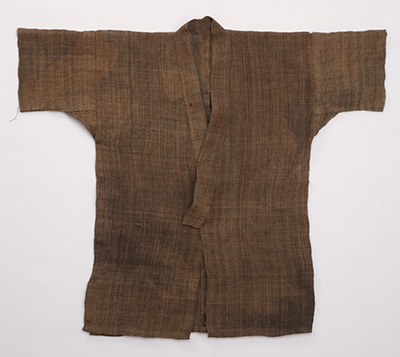- 科布 -
主に東北地方以北に自生している樹で、北海道を含む日本の北部で、多く布と して作られていた。仕事着や日常着以外にも、蚊帳や袋……あらゆる用途に使 われていた。
オヒョウや科は、樹の繊維なので、タンニン質が多く含まれており、染めてい ないのに時間がたつほど焦げ茶色に変色していく。同じタンニン質を持つ柿渋 で染めた大麻などの布とよく似ていて間違え易い。

Category

科布で作られた仕事着は現存するのが少ない。 同じ樹の繊維であるオヒョウや藤より、長く使用しても柔らかくなりにくいので、あまり衣服としては適さなかったのであろうか?
明治、大正時代 東北地方
Shigotogi Work wear
Linden fiber work garments are very rare. Compared to other cloth made of bast fibers from the same family of trees, such as elm and wisteria, linden cloth does not soften with continuous use. Is this why linden cloth was rarely used for making clothing?
Meiji - Taisho period (1868-1926)
Touhoku region
蚊帳地。腰機で織ってあるので、たて糸とよこ糸が適度にたわみ、高機で織っ たものには無い味わいになっている。
Kaya Mosquito net
Because this mosquito net is woven on a back-strap loom, the warp and weft bend nicely, creating a pleasing texture, which would not have been possible if a floor loom had been used.
- Shina -
Linden
Shina-fu Linden is a deciduous tree native to northern temperate regions. It grows in the Tohoku district of Japan and as well as on Hokkaido. Linden fibers are mostly used in these regions for making cloth. Linden cloth is constructed for all sorts of uses, such as clothing, mosquito nets and bags.
Elm and linden cloth naturally turn darker brown as time passes, due to the tannin content in these tree fibers. Elm and linden cloth are easily mistaken for other bast fiber cloth, such as hemp dyed with juice extracted from unripe, sour persimmons, which also contain tannin.
Linden
Shina-fu Linden is a deciduous tree native to northern temperate regions. It grows in the Tohoku district of Japan and as well as on Hokkaido. Linden fibers are mostly used in these regions for making cloth. Linden cloth is constructed for all sorts of uses, such as clothing, mosquito nets and bags.
Elm and linden cloth naturally turn darker brown as time passes, due to the tannin content in these tree fibers. Elm and linden cloth are easily mistaken for other bast fiber cloth, such as hemp dyed with juice extracted from unripe, sour persimmons, which also contain tannin.
Copyright 2002 Gallery Kei. All rights reserved.